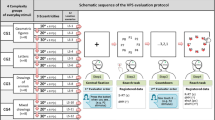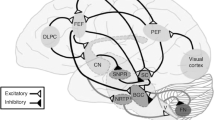Summary
Neuropsychological outcome within two years after injury was determined in 159 head injured patients who were classified into three groups according to the presence of either unilateral, bilateral, or no visual field defects (VFDs). The VFDs occurred irrespective of injury severity as determined by the Glasgow coma scale, or social outcome as determined by the Glasgow outcome scale. Differences among the three visual field groups were obtained for several neuropsychological functions: intelligence, memory, learning, acquired verbal skills, visuospatial skills, and visuomotor speed. Patients with bilateral VFDs were more severely impaired neuropsychologically than those with unilateral or no VFDs. Occurrences of secondary complications (brain swelling, intracranial hypertension, and hyperemia) were more prevalent among the bilateral VFD cases. The findings suggested that bilateral VFDs may be indicators of increased brain damage from secondary insults.
Similar content being viewed by others
References
Barth JT, Macciocchi SN, Giordani B, Rimel R, Jane JA, Boll TJ (1983) Neuropsychological sequelae of minor head injury. Neurosurgery 13: 529–533
Basso A, De Renzi E, Faglioni P, Scotti G, Spinnler H (1973) Neuropsychological evidence for the existence of cerebral areas critical to the performance of intelligence tasks. Brain 96: 715–728
Benton A (1962) Clinical symptomatology in right and left hemisphere lesions. In: Mountcastle VB (ed) Interhemispheric relations and cerebral dominance. Johns Hopkins Press, Baltimore, pp 253–263
Boortz-Marz R (1985) Factors affecting intracranial pressure: A descriptive study. J Neurosurg Nurs 17: 84–94
Borod JC, Carper M, Goodglass H (1982) WAIS performance IQ in aphasia as a function of auditory comprehension and constructional apraxia. Cortex 18: 199–210
Brooks DN, Aughton ME, Bond MR, Jones P, Rizvi S (1980) Cognitive sequelae in relationship to early indices of severity of brain damage after severe blunt head injury. J Neurol Neurosurg Psychiatry 43: 529–534
Brooks DN (1976) Wechsler memory scale performance and its relationship to brain damage after severe closed head injury. J Neurol Neurosurg Psychiatry 39: 593–601
Brooks DN (1974) Recognition memory after head injury: A signal detection analysis. Cortex 10: 224–230
Brooks DN (1972) Memory and head injury. J Nerv Ment Dis 155: 350–355
Crompton MR (1970) Visual lesions in closed head injury. Brain 93: 785–792
De Renzi E, Faglioni P (1967) The relationship between visuospatial impairment and constructional apraxia. Cortex 3: 327–342
Dixon WJ (1983) BMDP statistical software. University of California Press, Berkeley
Doehring DG, Reitan RM, Kløve H (1961) Changes in patterns of intelligence test performance associated with homonymous visual field defects. J Nerv Ment Dis 132: 227–233
Doehring DG, Reitan RM (1961) Language disorders in brain-damaged patients. Arch Neurol 5: 294–299
Heaton RK, Chelune GJ, Lehman RA (1978) Using neuropsychological and personality tests to assess the likelihood of patient employment. J Nerv Ment Dis 166: 408–416
Heilman KM, Valenstein E (1979) Mechanisms underlying hemispatial neglect. Ann Neurol 5: 166–170
Hughes B (1962) Indirect injury of the optic nerves and chiasma. Bull Johns Hopkins Hosp 3: 98–126
Jennett B, Snoek J, Bond MR, Brooks N (1981) Disability after severe head injury: observations on the use of the Glasgow Outcome Scale. J Neurol Neurosurg Psychiatry 44: 285–293
Jennett B, Teasdale G (1981) Management of head njuries. F. A. Davis, Philadelphia, pp 77–93
Katayama Y, Yoshida K, Ogawa H, Tsubokawa (1985) Traumatic homonymous hemianopsia associated with a juxtasellar hematoma after acute closed head injury. Surg Neurol 24: 289–292
Kløve H, Cleeland CS (1972) The relationship of neuropsychological impairment to other indices of severity of head injury. Scand J Rehab Med 4: 55–60
Langfitt TW, Gennarelli TA, Obrist WD, Bruce DA, Zimmerman RA (1982) Prospects for the future in the diagnosis and management of head injury: pathophysiology, brain imaging and population-based studies. Clin Neurosurg 29: 353–376
Laursen AB (1971) Traumatic bitemporal hemianopsia. Acta Ophthal 49: 134–141
Levin HS, Eisenberg HM, Wigg NR, Kobayashi K (1982) Memory and intellectual ability after head injury in children and adolescents. Neurosurgery 11: 668–673
Levin HS, Grossman RG, Kelly PJ (1976) Aphasic disorder in patients with closed head injury. J Neurol Neurosurg Psychiatry 39: 1062–1070
Levin HS, Grossman RG, Rose JE, Teasdale G (1979) Long-term neuropsychological outcome of closed head injury. J Neurosurg 50: 412–422
Luria AR (1973) The working brain. Penguin, London, pp 256–279
Mandleberg IA, Brooks DN (1975) Cognitive recovery after severe head injury. J Neurol Neurosurg Psychiatry 38: 1121–1126
Mesulam M-M (1986) Frontal cortex and behavior. Ann Neurol 19: 320–324
Mesulam M-M (1981) A cortical network for directed attention and unilateral neglect. Ann Neurol 10: 309–325
Miller JD, Becker DP, Ward JD, Sullivan HG, Adams WE, Rosner MJ (1977) Significance of intracranial hypertension in severe head injury. J Neurosurg 47: 503–516
Milner B, Petrides M, Smith ML (1985) Frontal lobes and temporal organization of memory. Human Neurobiol 4: 137–142
Narayan RK, Kishore PRS, Becker DP, Ward JD, Enas GG, Greenberg RP, DaSilva AD, Lipper MH, Choi SC, Mayhall CG, Lutz HA, Young HF (1982) Intracranial pressure: to monitor or not to monitor? J Neurosurg 56: 650–659
Norrman B, Svahn K (1964) A follow-up study of severe brain injuries. Acta Psychiatr Scand 37: 236–264
Obrist WD, Langfitt TW, Jaggi JL, Cruz J, Gennarelli TA (1984) Cerebral blood flow and metabolism in comatose patients with acute head injury. J Neurosurg 61: 241–253
Østerberg G (1938) Traumatic bitemporal hemianopsia (sagittal tearing of the optic chiasma). Acta Ophthal 16: 466–474
Parker SA, Serrats AF (1976) Memory recovery after traumatic coma. Acta Neurochir (Wien) 34: 71–77
Petrides M, Milner B (1982) Deficits on subject-ordered tasks after frontal- and temporal-lobe lesions in man. Neuropsychologia 20: 249–262
Reitan RM, Wolfson D (1985) The Halstead-Reitan neuropsychological battery. Neuropsychology Press, Tucson, Arizona, pp 15–37
Rowbotham GF (1964) Acute injuries of the head. E. & S. Livingstone, pp 410–419
Savino PJ, Glaser JS, Schatz NJ (1980) Traumatic chiasmal syndrome. Neurology 30: 963–970
Stuss DT, Benson DF, Kaplan EF, Weir WS, Naeser MA, Lieberman I, Ferrill D (1983) The involvement of orbitofrontal cerebrum in cognitive tasks. Neuropsychologia 21: 235–248
Stuss DT, Ely P, Hugenholtz H, Richard MT, LaRochelle S, Poirier CA, Bell T (1985) Subtle neuropsychological deficits in patients with good recovery after closed head injury. Neurosurgery 17: 41–46
Tibbs PA, Brooks WH (1979) Traumatic bitemporal hemianopsia: case report. J Trauma 19: 129–131
Traquair HM, Dott NM, Russell WR (1935) Traumatic lesions of the optic chiasma. Brain 58: 398–411
Turner JWA (1943) Indirect injuries of the optic nerve. Brain 66: 140–151
Uzzell BP, Langfitt TW, Dolinskas CA (1987) Influence of injury severity on quality of survival after head injury. Surg Neurol (in press)
Uzzell BP, Obrist WD, Dolinskas CA, Jaggi JL (1986) Correlation of acute ICP and CBF with CT scan and neuropsychological recovery in severe head injury. In: Miller JDet al (eds) Intracranial pressure VI. Springer, Berlin Heidelberg New York Tokyo pp 687–690
Uzzell BP, Obrist WD, Dolinskas CA, Langfitt TW (1986) Relationship of acute CBF and ICP findings to neuropsychological outcome in severe head injury. J Neurosurg 65: 630–635
Van Zomeren AH, Deelman BG (1978) Long-term recovery of visual reaction time after closed head injury. J Neurol Neurosurg Psychiatry 41: 452–457
Vries JK, Becker DP, Young HF (1973) A subarachnoid screw for monitoring intracranial pressure. Technical note. J Neurosurg 39: 416–419
Walsh FB, Hoyt WF (1969) Clinical neuro-ophthalmology, 3rd ed, vol 3. Williams and Wilkins, Baltimore, pp 2375–2386
Walsh FB (1966) Pathological-clinical correlation: I. Indirect trauma to the optic nerves and chiasm; II. Certain cerebral involvements associated with defective blood supply. Invest Ophthal 5: 433–499
Ward C (1978) Terminology and extent measures for digital head and neck injury records. Civil Engineering Laboratory, Naval Construction Battalion Center, Port Hueneme, California, pp 1–45
Zimmerman RA, Bilaniuk LT, Bruce D, Dolinskas C, Obrist W, Kuhl D (1978) Computed tomography of pediatric head trauma: acute general cerebral swelling. Radiology 126: 403–408
Author information
Authors and Affiliations
Additional information
This study was supported by NS 08803 from the U.S. National Institute of Neurological Communicative Disorders and Stroke.
Rights and permissions
About this article
Cite this article
Uzzell, B.P., Obrist, W.D., Dolinskas, C.A. et al. Relation of visual field defects to neuropsychological outcome after closed head injury. Acta neurochir 86, 18–24 (1987). https://doi.org/10.1007/BF01419499
Issue Date:
DOI: https://doi.org/10.1007/BF01419499




